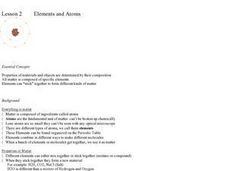Curated OER
Living Environment
In this environment worksheet students complete a series of multiple choice questions and short answers on plant and animal species and populations in an ecosystem.
Curated OER
Hot Air Balloons
Young scholars examine how a hot air balloon works. In this hot air balloon instructional activity, students do an experiment to test the effects of heat on density. Young scholars make their own hot air balloon and act out how nitrogen...
Curated OER
Polymer Chemistry: More than Just Plastic
Fifth graders examine polymers and how they are formed. In this chemistry lesson students complete their own polymer experiment then discuss what they learned.
American Chemical Society
Air, It's Really There
Love is in the air? Wrong — nitrogen, oxygen, and carbon dioxide are in the air. The final lesson in the series of five covers the impact of temperature on gases. Scholars view a demonstration of gas as a type of matter before performing...
American Chemical Society
The Discovery of Fullerenes
Carbon is the most common element on earth, so the innovative discovery of a new type of carbon molecule won the 1996 Nobel Prize. In the ready-to-go lesson, scholars learn about C60 and how it has opened up the entire area of...
Curated OER
Polymers all Over the Place
Students investigate properties of common molecules. For this chemistry lesson, students construct polymer models to gain a better understanding of the properties of polymers.
Curated OER
Water Chemistry
Students engage in a lesson that is concerned with the concept of water chemistry. They conduct research using a variety of resources. Students also consider an experiment to observe how water has the abiility to exist as three different...
Curated OER
The Structure of Materials
Students brainstorm what matter is and how they define it. They construct a water molecule with marshmallows and toothpicks. In addition, they watch videos to explore the use the idea of nanoscience to investigate the properties of...
Curated OER
Changes of State
Students examine molecules and the changes in energy of a system. In this energy systems lesson students complete a lab activity and describe changes of state.
Curated OER
How Does a Liquid Become a Solid?
Students explore the energy changes from a liquid to a solid. They model the arrangement of a solid and the change in states due to changes in energy using desks and chairs. Assessment questions are provided in lesson plan.
Curated OER
Density - An Introduction
Students experiment with objects of different densities. In this density instructional activity, students examine same-sized objects with different weights, then look at a teacher explanation of density. Students make wave bottles and...
Curated OER
Air, Air-It's Everywhere!
Students engage in experiment activities, which illustrate that air is made of matter, does take up space, and is very important to our health. This lesson contains activities for a variety of grade levels. A very nice idea!
Curated OER
Putting the Ice in Hockey
Eighth grade physical science classes examine why the ice on which hockey is played is slippery. They do so by discussing phases of matter and the molecular motion in each. They read an article on a website and write out answers to...
Curated OER
Periodic Table of the Elements
First graders discuss, at their level, the concept of elements making up all matter. They discover the story of Dimitri Mendeleev and his discovery of the Periodic Table of the Elements. They locate and color some of the most common...
Curated OER
Elements And Atoms
Students investigate the concept of elements and atoms. They conduct research using a variety of resources and use the information in order to create a class presentation. The instructional activity includes specific dialogue and steps...
Curated OER
Doing Lewis Dot Diagrams
Students observe the periodic table and draw the Lewis Dot Diagram. In this investigative instructional activity students construct information on several elements including the Lewis Dot Formation and take a quiz on the...
Curated OER
HOW SMALL AM I? THE SCIENCE OF NANOTECHNOLOGY
Young scholars study nanotechnology and investigate the dimensions of a nanoscale. In this nanometer study lesson students will see how truly small a nanometer is by measuring things such as a piece of hair.
Curated OER
Water and Ice
Learners examine water. In this chemistry lesson plan, student examine the physical properties of water and how it changes from a liquid to a solid or a gas. This lesson plan contains links to a second and third complimentary lesson plan...
Curated OER
A Model of a Scanning Tunneling Microscope
Ninth graders explain how a scanning tunneling microscope works. In this chemistry instructional activity, 9th graders construct atomic models and simulate how their images appear under the STM. They discuss the limitations of their...
Curated OER
Somethin' Sweet
Students make their own candy. In this science lesson plan, students observe how molecules interact with each other in physical changes and observe how the addition of heat can cause molecules to interact and form new molecules in...
Curated OER
Does Size Matter?
Students explore chemical solutions. In this chemistry lesson, students investigate the relationship between three related experiments about solutions. Students determine variables that affect the chemical concentration of each solution.
Curated OER
Density: Floating, Sinking, and Suspending
Students observe teacher demonstrations that illustrate density. In this density lesson plan, the teacher demonstrates how air bubbles in a carbonated drink can cause a raisin to float and how an egg sinks in fresh water, but floats in...
Cornell University
Glued into Science—Classifying Polymers
Explore the unique characteristics of polymers. A complete lesson plan begins with a presentation introducing polymers. Following the presentation, young scientists develop a laboratory plan for creating substances using polymers....
Cornell University
Polymers: Making Silly Putty
Putty is proof that learning can be fun! Share the wonderful world of polymers with your class through an experiment. Young scientists create their own silly putty, then examine its properties.























